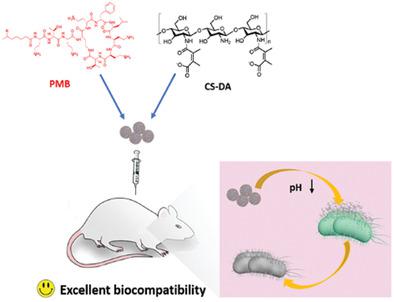当前位置:
X-MOL 学术
›
Adv. Healthcare Mater.
›
论文详情
Our official English website, www.x-mol.net, welcomes your
feedback! (Note: you will need to create a separate account there.)
Polymyxin B-Polysaccharide Polyion Nanocomplex with Improved Biocompatibility and Unaffected Antibacterial Activity for Acute Lung Infection Management.
Advanced Healthcare Materials ( IF 10.0 ) Pub Date : 2020-01-03 , DOI: 10.1002/adhm.201901542 Mengying Chai 1 , Yifan Gao 1 , Jun Liu 1 , Yongyan Deng 1 , Dengfeng Hu 1 , Qiao Jin 1 , Jian Ji 1
Advanced Healthcare Materials ( IF 10.0 ) Pub Date : 2020-01-03 , DOI: 10.1002/adhm.201901542 Mengying Chai 1 , Yifan Gao 1 , Jun Liu 1 , Yongyan Deng 1 , Dengfeng Hu 1 , Qiao Jin 1 , Jian Ji 1
Affiliation

|
The decade-old antibiotic, polymyxin B (PMB), is regarded as the last line defense against gram-negative "superbug." However, the serious nephrotoxicity and neurotoxicity strongly obstruct further application of this highly effective antibiotic. Herein, a charge switchable polyion nanocomplex exhibiting pH-sensitive property is proposed to deliver PMB which is expected to improve the biosafety of PMB on the premise of retaining excellent antibacterial activity. The polyion nanocomplex is prepared through electrostatic interaction of positively charged PMB and negatively charged 2,3-dimethyl maleic anhydride (DA) grafted chitoligosaccharide (CS). The negative charge of CS-DA will convert to positive due to the hydrolysis of amide bonds in acidic infectious environment, leading to the disassembly of CS-DA/PMB nanocomplex and release of PMB. CS-DA/PMB nanocomplex does not show significant toxicity to mammalian cells while retaining excellent bactericidal capability equivalent to free PMB. The nephrotoxicity and neurotoxicity of CS-DA/PMB dramatically decrease compared to free PMB. Moreover, CS-DA/PMB nanocomplex exhibits superior bactericidal activity against Pseudomonas aeruginosa in an acute lung infection mouse model. The pH-sensitive polyion nanocomplexes may provide a new way to reduce the side effects of highly toxic antibiotics without reducing their intrinsic antibacterial activity, which is the key factor to achieve extensive in vivo clinical applications.
中文翻译:

具有改善的生物相容性和不受影响的抗菌活性的急性肺部感染管理的多粘菌素B-多糖聚离子纳米复合物。
已有十年历史的抗生素多粘菌素B(PMB)被视为对抗革兰氏阴性“超级细菌”的最后一道防线。但是,严重的肾毒性和神经毒性强烈阻碍了这种高效抗生素的进一步应用。在本文中,提出了显示pH敏感性的电荷可切换的聚离子纳米复合物以递送PMB,其期望在保持优异的抗菌活性的前提下提高PMB的生物安全性。通过带正电的PMB和带负电的2,3-二甲基马来酸酐(DA)接枝的寡糖(CS)的静电相互作用,制备了聚离子纳米复合物。由于酸性感染环境中酰胺键的水解,CS-DA的负电荷将转换为正电荷,从而导致CS-DA / PMB纳米复合物的分解和PMB的释放。CS-DA / PMB纳米复合物对哺乳动物细胞没有明显的毒性,同时保留了与游离PMB相当的优异杀菌能力。与游离PMB相比,CS-DA / PMB的肾毒性和神经毒性显着降低。此外,CS-DA / PMB纳米复合物在急性肺部感染小鼠模型中对铜绿假单胞菌显示出优异的杀菌活性。pH敏感的聚离子纳米复合物可能提供一种减少高毒性抗生素副作用而又不降低其固有抗菌活性的新方法,这是实现广泛的体内临床应用的关键因素。与游离PMB相比,CS-DA / PMB的肾毒性和神经毒性显着降低。此外,CS-DA / PMB纳米复合物在急性肺部感染小鼠模型中对铜绿假单胞菌显示出优异的杀菌活性。pH敏感的聚离子纳米复合物可能提供一种减少高毒性抗生素副作用而又不降低其固有抗菌活性的新方法,这是实现广泛的体内临床应用的关键因素。与游离PMB相比,CS-DA / PMB的肾毒性和神经毒性显着降低。此外,CS-DA / PMB纳米复合物在急性肺部感染小鼠模型中对铜绿假单胞菌显示出优异的杀菌活性。pH敏感的聚离子纳米复合物可能提供一种减少高毒性抗生素副作用而又不降低其固有抗菌活性的新方法,这是实现广泛的体内临床应用的关键因素。
更新日期:2020-02-06
中文翻译:

具有改善的生物相容性和不受影响的抗菌活性的急性肺部感染管理的多粘菌素B-多糖聚离子纳米复合物。
已有十年历史的抗生素多粘菌素B(PMB)被视为对抗革兰氏阴性“超级细菌”的最后一道防线。但是,严重的肾毒性和神经毒性强烈阻碍了这种高效抗生素的进一步应用。在本文中,提出了显示pH敏感性的电荷可切换的聚离子纳米复合物以递送PMB,其期望在保持优异的抗菌活性的前提下提高PMB的生物安全性。通过带正电的PMB和带负电的2,3-二甲基马来酸酐(DA)接枝的寡糖(CS)的静电相互作用,制备了聚离子纳米复合物。由于酸性感染环境中酰胺键的水解,CS-DA的负电荷将转换为正电荷,从而导致CS-DA / PMB纳米复合物的分解和PMB的释放。CS-DA / PMB纳米复合物对哺乳动物细胞没有明显的毒性,同时保留了与游离PMB相当的优异杀菌能力。与游离PMB相比,CS-DA / PMB的肾毒性和神经毒性显着降低。此外,CS-DA / PMB纳米复合物在急性肺部感染小鼠模型中对铜绿假单胞菌显示出优异的杀菌活性。pH敏感的聚离子纳米复合物可能提供一种减少高毒性抗生素副作用而又不降低其固有抗菌活性的新方法,这是实现广泛的体内临床应用的关键因素。与游离PMB相比,CS-DA / PMB的肾毒性和神经毒性显着降低。此外,CS-DA / PMB纳米复合物在急性肺部感染小鼠模型中对铜绿假单胞菌显示出优异的杀菌活性。pH敏感的聚离子纳米复合物可能提供一种减少高毒性抗生素副作用而又不降低其固有抗菌活性的新方法,这是实现广泛的体内临床应用的关键因素。与游离PMB相比,CS-DA / PMB的肾毒性和神经毒性显着降低。此外,CS-DA / PMB纳米复合物在急性肺部感染小鼠模型中对铜绿假单胞菌显示出优异的杀菌活性。pH敏感的聚离子纳米复合物可能提供一种减少高毒性抗生素副作用而又不降低其固有抗菌活性的新方法,这是实现广泛的体内临床应用的关键因素。











































 京公网安备 11010802027423号
京公网安备 11010802027423号